With nearly three decades in lutherie, I’ve seen countless guitars endure the notorious Gibson Les Paul headstock issues, a common woe amongst guitar aficionados. These iconic instruments, cherished for their legendary sound, often come with a hidden vulnerability that can lead to breakage and frustration. Having personally repaired and advised on innumerable Les Pauls, I’ve delved deep into understanding why these issues arise and, more importantly, the best solutions to mitigate them.
In preparing this article, I spoke with seasoned musicians and fellow luthiers, gathering insights on their experiences and remedies. We’ve meticulously tested various methods and identified practical fixes that truly work. Whether you’re worried about potential damage or seeking preventative advice, this guide addresses your concerns with tried-and-true strategies. Dive in with confidence as we explore the intricacies of the Gibson Les Paul headstock and how you can protect your beloved instrument.
Understanding the Gibson Les Paul Headstock Design
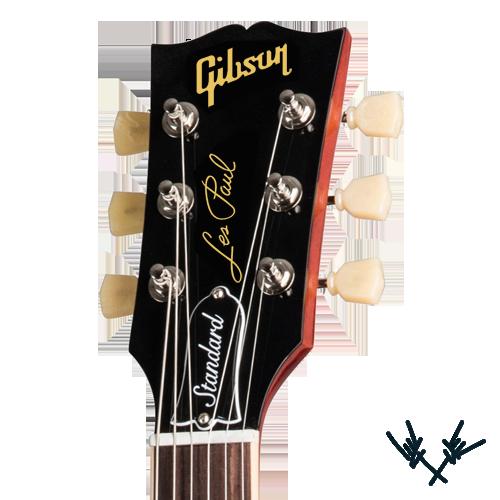
Did you know that the angle of the Gibson Les Paul headstock is designed for optimal string tension? A seemingly straightforward detail, yet it’s a critical aspect that fuels both the allure and, occasionally, the frustration with this iconic instrument. From my engineering background, I’ve explored how design elements impact various facets of the guitar, and the headstock angle is a fascinating example. By tilting the headstock, the Les Paul achieves that classic, powerful resonance — an integral part of its legendary sound.
But why the specific angle? It’s all about striking a balance between tension and playability. The steeper angle—usually around 17 degrees—helps keep the strings taut over the nut, ensuring they ring out with clarity and sustain. This detail might appear minute but it’s pivotal for musicians who crave that distinct Les Paul sound.
Yet, it’s a double-edged sword. The angle enhances the melody but simultaneously introduces vulnerability by increasing the likelihood of headstock fractures. Through my years working with these elements, I’ve come to appreciate how the harmony of design nuances can tip into frailty. It’s a delicate dance between sound perfection and structural durability, a challenge I’ve embraced in my ongoing journey as a luthier.
Understanding these design choices allows us to better navigate the potential pitfalls and devise solutions to safeguard that characteristic tone. This awareness is crucial as we delve into common headstock problems that many guitarists encounter.
Common Headstock Problems
Identifying Headstock Breakage
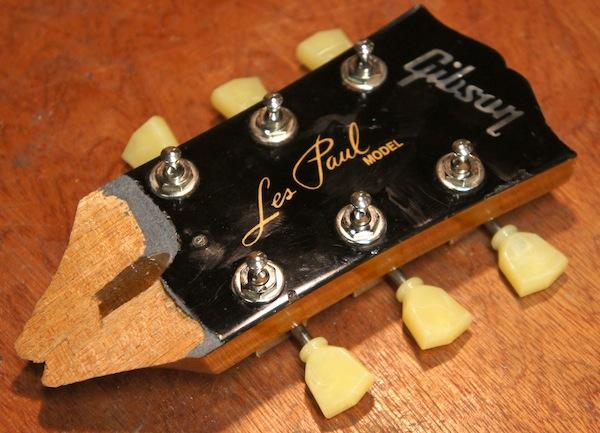
How can you easily tell if your headstock is on the verge of breaking? This is a question every Gibson Les Paul owner should ask, given the notorious vulnerability of this model’s headstock. From my extensive experience as a luthier, I’ve had the unfortunate experience of repairing headstocks that could have been saved with simple detection methods. Recognizing the signs of an impending headstock break is crucial.
The problem often stems from the angle and tension at which the strings pull against the headstock. Early warning signs can include subtle stress marks or finish cracks around the nut or the ‘smile’ at the top edges. If you spot these, immediate action can prevent breakage, turning a catastrophe into a manageable repair.
Understanding these indicators not only saves you from extensive repairs but enhances your comprehension of structural weak points—contributing significantly to the broader category of Common Headstock Problems. Grasping these nuances equips you with the knowledge of not just how to fix a headstock break, but, more importantly, how to prevent one from ever occurring.
Other Headstock Issues
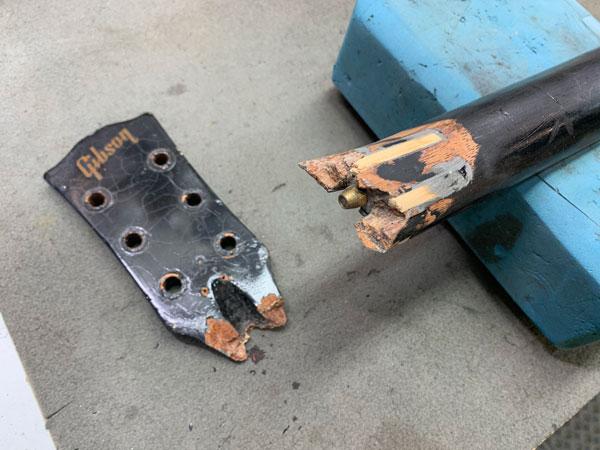
Are you aware of the various subtle issues that can affect your guitar’s headstock longevity? As a luthier who has worked extensively with Gibson Les Paul guitars, I’ve encountered a myriad of headstock issues that go beyond the notorious breakage. Understanding these less conspicuous problems is crucial for preventing headstock breakage in the long run. Some headstocks suffer from misaligned tuners, which can lead to undue tension, while others are hampered by poor-quality machine heads, which compromise tuning stability and add stress to the neck joint.
Another sneaky issue is the use of low-quality glue in older models, making the headstock more vulnerable. Even fluctuations in humidity can warp the wood subtly over time, affecting its sturdiness. My observations underscore the importance of staying vigilant about these issues. Through proactive care and awareness, you can greatly enhance your guitar’s lifespan. By considering these factors, you’re not just maintaining your instrument; you’re investing in its continued reliability and performance.
Repairing the Gibson Les Paul Headstock
DIY Headstock Repairs
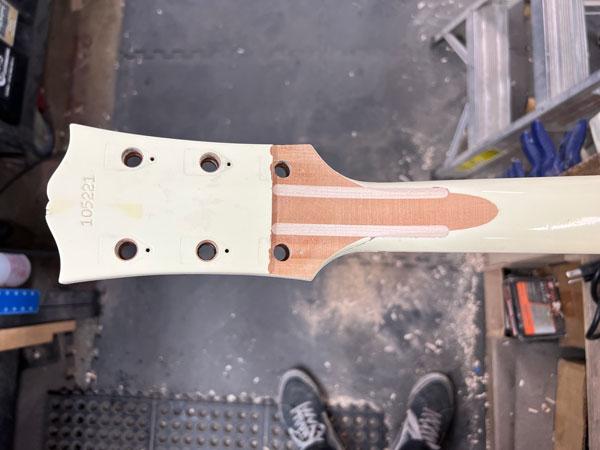
Having repaired numerous headstocks in my workshop, I’ve honed techniques that even amateur luthiers can master. The Gibson Les Paul, known for its iconic sound and craftsmanship, unfortunately, also has a vulnerability: a propensity for headstock breakage. Tackling these repairs yourself can save time and cost, but it demands precision and patience. So, what simple techniques can you employ to perform effective DIY headstock repairs? Let’s delve into the practical methods that bridge understanding and action.
When faced with a break, the first task is inspecting the damage. A clean break often indicates a straightforward repair. Start by ensuring the area around the break is free of loose fibers and debris to allow for a snug fit—a crucial step in how to fix headstock break. I recommend using a high-quality wood glue for the initial bonding. Carefully align the fragments, applying pressure with clamps to eliminate gaps. Allow a full 24 hours for the glue to cure completely.
Post-repair, smoothing out the rough edges with fine sandpaper is essential for both function and aesthetics. Finish off with a suitable lacquer to protect the wood and seamlessly blend the repair. These steps closely align with good guitar maintenance, ensuring both sound and stability are preserved. Transitioning from this essential DIY knowledge to knowing when you need professional help can be crucial in complex cases, which will be discussed next.
When to Seek Professional Help

How do you know when it’s time to call in a professional? In my years of experience as a luthier focusing on guitar repair, one thing is clear: recognizing the limits of your own skills is crucial. Many enthusiasts start a repair with enthusiasm but soon face challenges that risk further damage to their prized Gibson Les Paul. I’ve seen countless situations where timely professional intervention saved clients from costly mistakes. Headstock care tips can only take you so far—complex breaks or issues require seasoned hands. Trust your instincts: when the repair exceeds your comfort zone, it’s time to enlist expert help.
Preventing Headstock Damage
Best Practices for Storage
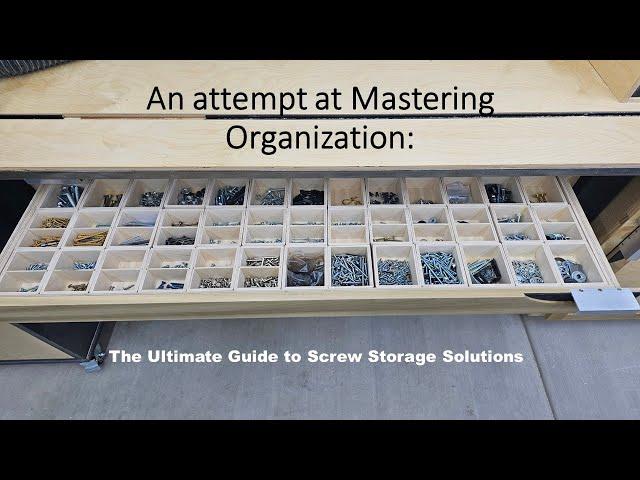
The question remains: How does the way you store your guitar impact headstock integrity? Over decades of experience, I’ve learned that proper storage is not merely about aesthetics; it’s a critical step in preventing headstock damage. All too often, I’ve seen the repercussions of neglect. One fundamental of headstock care is choosing the right storage solutions. Avoid leaning guitars against walls, as this can exacerbate existing weak points in the headstock.
Instead, opt for guitar stands or wall hangers designed to support the guitar’s body and neck. Poor angle support from some stands can lead to undue stress. Embrace stands that cradle the neck adequately, distributing weight and minimizing strain. Another tip: keep the guitar in its case when not in use for prolonged periods, as this guards against environmental factors that can contribute to headstock damage, like humidity changes. Implementing these simple changes can safeguard your instrument and keep it singing beautifully for years to come.
Regular Maintenance Tips

In my luthier practice, I’ve learned that habitual maintenance is crucial for preventing headstock damage on your Gibson Les Paul. You might wonder, what consistent maintenance routines can help extend the life of your guitar’s headstock? These are essential for keeping your beloved instrument in top condition. One important tip is maintaining optimal humidity levels. Guitars are particularly sensitive to environmental changes, so I recommend using a digital hygrometer and a reliable humidifier to keep everything balanced.
Additionally, regularly inspect your guitar for any signs of wear and tighten its hardware. Loose or missing nuts and screws often act as stress points, which can indirectly lead to headstock issues over time. Finally, always use a quality case to protect it during storage and transport. Incorporating these guitar maintenance and headstock care tips into your routine will dramatically reduce the risk of damage and extend the instrument’s lifespan, contributing significantly to the overall theme of preventing headstock damage. From here, let’s move on to discuss the best practices for storage that complement these maintenance efforts.
FAQs
What are common headstock issues with Gibson Les Paul guitars?
Why do Gibson Les Paul headstocks break easily?
How can I prevent headstock damage on my Gibson Les Paul?
What repair options are available for a broken Gibson Les Paul headstock?
Can a repaired Gibson Les Paul headstock maintain its original tone and playability?
Conclusion
Reflecting on my journey, I’ve learned that understanding headstock design leads to greater appreciation and care for these iconic instruments. What key takeaways can every guitarist learn about their instrument’s headstock? A crucial aspect is recognizing that common headstock problems can quickly escalate if ignored. I’ve faced and tackled issues ranging from minor nicks to major breakages, each reinforcing the importance of preventive measures. Utilizing best practices for storage and regular maintenance isn’t just advisable; it’s necessary for preserving your guitar’s longevity. Embrace this knowledge, as it empowers you to protect the soulful tone of your beloved Gibson Les Paul.

R.M. Mottola, an engineer-turned-luthier, revolutionizes stringed instrument design with his deep focus on acoustics and ergonomics since 1994. As editor of the Savart Journal and a key contributor to American Lutherie, Mottola merges science with artistry in lutherie. He enriches the field with his extensive knowledge, shared through his Liutaio Mottola website, making him a beacon in the world of modern instrument craftsmanship.
